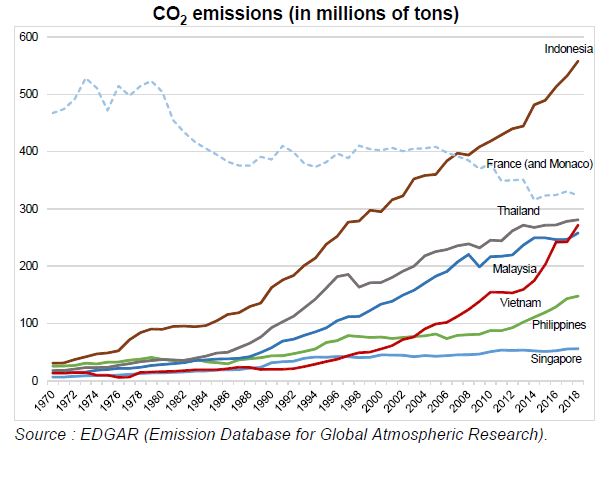Energy transition issues within ASEAN
The energy transition is a major challenge for ASEAN, whose sustained economic development is accompanied by rising carbon dioxide emissions. At a time when the region is particularly exposed to the effects of climate change, several levers of action could be mobilized to accelerate the energy transition and align the CO2 emissions trajectory with the objectives of the Paris Agreement.
The economic expansion of the Association of Southeast Asian Nations (ASEAN) has been matched by an average annual increase in energy consumption of 3.4% since the turn of the century. Consumption is forecast to continue rising by an annual average of 2.2% until 2040. Fossil fuels generate three-quarters of the region's energy: oil (35%), coal (21%) and gas (19%).
Higher energy consumption is primarily responsible for the fact that carbon dioxide (CO2) emissions have risen, on average, by more than 4% per year since the year 2000. An additional two-thirds increase is expected between now and 2040. This is out of sync with International Energy Agency (IEA) scenarios that would ensure compliance with the Paris Agreement.
In 2018, ASEAN produced 4.3% of global CO2 emissions excluding deforestation as against only 1.8% in 1990. The most-populated country, Indonesia, is the main CO2 emitter and accounts for one third of emissions, followed by Thailand, Vietnam and Malaysia.
Nevertheless, ASEAN emits 50% less CO2 per inhabitant than the world average, with divergences depending on the extent of the country's development. Moreover, due to the fact that it manufactures goods for the rest of the world and is a net exporter, the region "consumes" less CO2 than it generates.
Southeast Asia is especially vulnerable to the effects of climate change and could be confronted with economic losses of up to 11% of annual GDP by 2100 on the basis of current trends.
In spite of the foregoing, the region's authorities appear to be focusing on economic development as the energy transition carries short-term costs with it. For instance, the energy mix is slated to still be comprised of three-quarters fossil fuels in 2040.
A number of steps could be taken to speed up the energy transition in ASEAN such as the gradual phasing out of fossil fuel subsidies, carbon pricing, incentives for private investments in renewable energies and the preparation of a regulatory framework to bolster energy efficiency.
.
